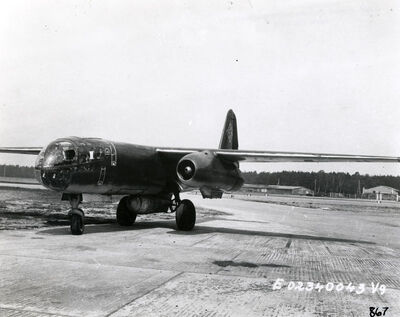
Arado Ar 234
The Arado Ar 234 was a German World War II jet bomber made by Arado.
Design and Development[]
The project began in 1940 at the request of the Nazi Air Ministry RLM. They wanted a reconnaissance plane powered by the new turbo jets which were at the time in development at Junkers and BMW. The aeroplane was first dubbed the E.370, but it was later re-named the Ar 234.
The aircraft was designed with a narrow fuselage with the wings mounted on top of the fuselage. The jet engines were attached on the underside of the wings. Most of the aircraft was occupied with fuel tanks due to the fact that RLM wanted a long range aircraft (Ar 234 had a range of 1,243 miles/2,000 km). With so much space allocated to the tanks, there was no room for a conventional undercarriage. Arado's solution was to use a detachable mounted trolley for take off and a central skid for landing. In later models, however, these were removed because the landing skid was considered too flawed and dangerous to continue using. Plus, once the aircraft had landed on the skid it couldn't move under its own power, so it had to wait for a special truck to take it back to the main hangars. This made it a sitting duck, vulnerable to Allied strafing attacks. In later models, this problem was finally solved by moving the central fuel tank out of the way and raising the nose wheel behind the pilot ejector seat.
Usage[]
V5 and V7 were the first two aircraft to see service in the war. They were sent to France in the immediate aftermath of the D-Day landings, although only one aircraft made it due to engine problems. It went on just three sorties, lasting around 10 minutes each to photograph the entire Allied-occupied area from Averanches to Caen. This was the first mission undertaken by the Ar 234; it came up againest no opposition.
The Allies made scored the first Ar 234 kill on 11th February 1945, when a Hawker Tempest shot down the Arado over Hull, United Kingdom.
The first bombing raid made by the Ar 234's happened on the 24th December 1944 when nine 234 bombers of 9th Staffel of Kampfgeschwader 76, led by Hauptmann Diether Lukesch and each carrying one 500kg bomb, attacked the railway yards at Leige: the raid was an outright success, with damage limited to a minor wing scrape suffered by one aircraft due to undercarriage failure.[1] Then, one week later they attacked Allied airfields. During January 1945 they attacked Liege once more, as well as Bastogne, and Antwerp. In February more Ar 234's were converted to bombers, though by that time it was too late-- fuel shortages, a problem that had gradually choked the Luftwaffe over the course of the war, essentially grounded the aircraft
The last operation of the 234's was to bomb the bridge at Remangen in an attempt to halt the advancing Americans. Five planes were lost in the process.
Over the next few weeks, more aircraft were converted to bombers, only to be handed over to the Allies without seeing any action.
References[]
- ↑ Take Off magazine. Aerospace Publishing Ltd. 1994-1996. Issue 79: Page 2193